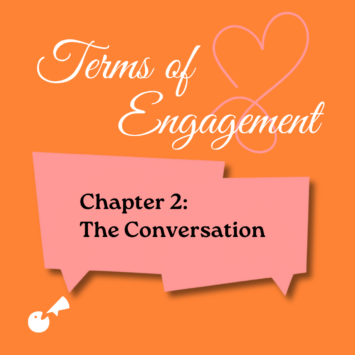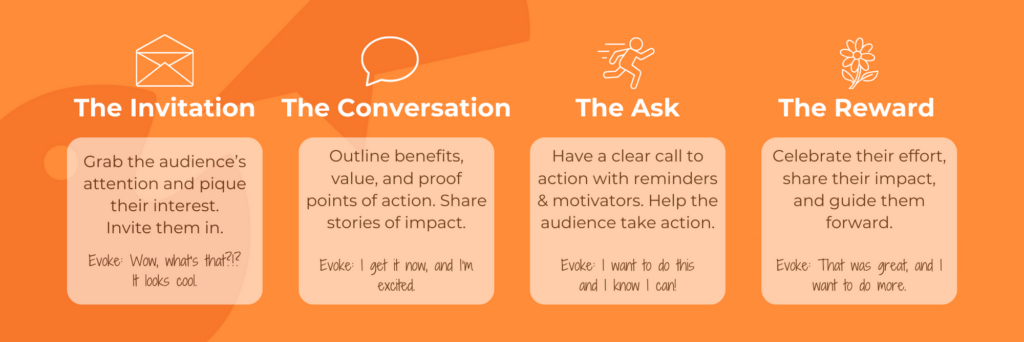
Terms of Engagement: Chapter 2, The Conversation.
Terms of Engagement continued.
Welcome back!
In this series, we’re walking through outreach stages where we deepen the connection and engagement with the audience as they continue along their journey of change.
In the previous post, we covered Chapter 1 on extending an invitation to the audience to join our efforts.
Today, we’ll move into Chapter 2 on the conversation. (It’s not about the birds and the bees, so don’t worry!)
-
Chapter 1: The Invitation.
-
Chapter 2: The Conversation (this post).
-
Chapter 3: The Ask.
-
Chapter 4: The Reward.
Chapter 2: The Conversation.
This step does not exist in the original AIDA model, which I roughly based these stages upon, yet it’s an important part of the journey. As a result, many advertisers add a step for “comprehension” to fill the gap. While comprehension may be our desired outcome, I like to think of this engagement process as a conversation.
At this point, a segment of your intended audience has opted to join your event or click a link for more details, which lands them in the conversation stage.
The goal of this stage is to provide more substance behind the initial invitation and evoke a feeling of, “I get it now, and I’m excited!”
You have their attention in this moment. Use it, don’t lose it.
Keeping the audience engaged in the first few moments of this stage is critical.
If they take the time to register or click, they are interested in what you have to say but can quickly get turned off (or bored) if they immediately encounter content that does not match their energy or excitement levels.
Prioritizing which information you share first is essential for this stage. The invitation got the audience to pull up a chair. The conversation that follows must entice them to hang around and continue the journey.
Consider how you can kick off this stage using one or more of the following approaches.
Note: the examples provided in italics are all completely made up.
» Lead with a welcoming, celebratory message that they’ve joined the effort.
We’re excited you joined the clean climate crew! Welcome!
» Showcase what the effort has already achieved and what it wants to accomplish next with the audience’s help.
Since 2021, more than 20,000 people have participated in No Mow May. With your help, we hope to raise this number to 35,000 in the next two years.
» Share a “wow” moment by presenting interesting data about the solution or the need.
Swapping out just one meat-based meal a week can reduce our global greenhouse gas emissions by 15%
» Describe how the audience can play a vital role in moving the effort forward.
Turning off your outdoor lights at night creates a safer migration path for birds.
» Offer something fun they can do, like a quick quiz or game related to the topic.
Take this quick quiz to test your reducing, reusing, and recycling skills!
» Outline the benefits the audience receives from taking action.
Shopping with a meal plan can save your family $1,500 a year and prevent food from ending up in a landfill.
» Draw the audience in with a compelling, personal story.
For years, Raphael struggled with wild animals damaging his crops and livestock, which impacted his income. But he never liked harming them to protect his farm, so he set out to find a better way.
» Ask the audience to share their ideas and experiences.
What is the most challenging aspect of taking public transportation or biking instead of driving to work?
After presenting these intro prompts, you can dive deeper into the cause or the desired behavior in ways you could not explain during the previous stage.
When and where the conversation happens.
Suppose you are hosting a booth for your organization at an event. You crafted a successful invitation “pitch” that gets eventgoers over to your booth. How will you keep them engaged now that you’ve caught their attention and interest?
We all know that feeling when someone comes to the table and takes a quick look, gives a brief smile (if we’re lucky), and then moves on. Ugh. Starting a conversation helps us avoid that dreaded experience.
In this setting, this may involve asking the audience a question, like “Can you guess the top household practice that can reduce greenhouse gas emissions?” Or something more lighthearted, like “What’s your favorite way to reduce your personal footprint?” or “When was the last time you saw a whale in the ocean?”
This lead-in helps you know your audience better and then follow up with a story, data point, or information that is most relevant to them. Now, you’re tailoring your message to them, which keeps them interested, engaged, and ready to take action.
If you deliver a webinar or in-person presentation, start with a poll, a question in the chat box, or a prompt to which the audience can raise their hands.
If this stage occurs more passively, like on a website, try to keep the language as welcoming and conversational as possible so the audience still feels you’re talking directly to them.
Right on the heels of this stage is Chapter 3: The Ask. The following post discusses ways to keep the audience’s momentum going with a clear call to action.
P.S. This video can help you organize your content so the audience sees your most important messages.



